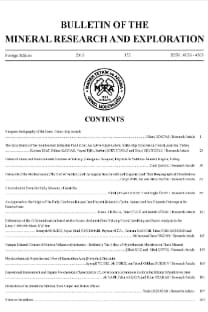Characterization and dewatering of borax clayey tailings by mono- and dual-flocculants systems
This study includes dewatering of Kırka Borax Concentrator tailings by flocculation with mono- and dual-fl occulants systems. Four polyacrylamide (PAM)-typed anionic and a poly diallyl-dimethylammonium chloride (PolyDADMAC)-typed cationic polymers were used as fl occulants in monoand dual-flocculants systems to fl occulate tailings. Tailings slurry sample used in the experiments were taken from the discharge point of Kırka Borax Concentrator. Prior to the fl occulation tests, physical, chemical and mineralogical analysis were carried out to characterize the tailings slurry. Results reveal that while tailings solid consists mainly of dolomite and montmorillonite with some unrecoverable boron mineral fi nes and very minor amount of calcite and quartz, tailings water is typical with the content of quite high dissolved carbonate and borax with a pH of 9.4. Flocculation tests were performed in one liter graduated cylinder at inherent pH of the tailings slurry sample. Settling rate and turbidity of overfl ow was measured as important factors for evaluating the fl occulation performance of different fl occulants. The tailings slurry as received showed a very low settling behavior due to the clay content and high percentage of fi ne particles. Flocculation of tailings with anionic fl occulants accelerated the settling rate of particles without providing a clear supernatant. But, dual-fl occulants system, in which anionic and cationic type polymeric fl occulants were used, was able to provide a clear supernatant at relatively higher settling rates.
Keywords:
beneficiation, tailings, dewatering, flocculation Borax,
___
- Akdeniz, Y. Özmıhçı, F. Duvarcı, Ç.Ö. Balköse, D. Ülkü, S. 2003. Characterization of colloidal phase in hot aqueous solutions of Kırka tincalconite mineral. XI. National Clay, 3-6 September 2003. İzmir, 603-613.
- Çebi, H. Yersel E. Poslu K. Behar A., Nesner R. Laangenbrick R.N. 1994. Solid-liquid separation of Etibank kırka Borax Plant effluents by centrifugal decanter, in: H. Demirel, S. Sayin (Eds.), Progress in Mineral Processing Technology, A.A. Balkema, Rotterdam, 513-516.
- Çırak, M., Hoşten, Ç., 2012. Preliminary flocculation study of two different clay suspensions in borax solution, proceedings of the 15th national clay Symposium of Turkey 2012. 261-271.
- Çırak, M. Hoşten, Ç. 2015. Characterization of clay rock samples of a borax ore in relation to their problematical flocculation behavior. Powder Technology, 284, 452-458.
- Garrett, D.E. 1998. Borates: Handbook of Deposits, Processing, Properties and Use, Academic Press, San Diego, 1998.
- Gregory, J. 1985. The use of polymeric flocculants. In: Proceedings of the Engineering Foundation Conference on Flocculation, Sedimentation and Consolidation, The Clister Sea Island, Georgia, USA, 125–137.
- Gregory, J. 1987. Flocculation by polymers and polyelectrolytes. In: Tadros, Th.F. (Ed.), Solid/liquid Dispersions. Academic Press, London, 163–181.
- Gür G. Turkay, S. Bulutcu, A.N. 1994. The effects of the process conditions on the flocculation of tincal slimes, in: H. Demirel, S. Sayin (Eds.), Progress in Mineral Processing Technology, A.A. Balkema, Rotterdam, 501–503.
- Gur G. Turkay, S. Bulutcu, A.N. 1996. Comparison of polyethylene oxide and polyacrylamides as flocculating agent for the flocculation of tincal slimes, in: M. Kemal, et al., (Eds.), Changing Scopes in Mineral Processing, A.A. Balkema, Rotterdam, 649–653.
- Hançer M. Kaytaz Y. Çelik M.S. 1993. Flotation of borax with anionic and cationic collectors in saturated solutions, proceeding of 13rd Mining Congress, 519-527.
- Helvacı C. 2015. Geological features of Neogene basins hosting borate deposits: an overview of the deposits and future forecast, Turkey. Bulletin of Mineral Research and Exploration, 151:173-219.
- Hosten, C. Çırak, M, 2013. Flocculation behavior of clayey dolomites in borax solutions, Powder Technol., 235, 263–270.
- Karapınar N. 2016. Investigation of dewatering possibilities of Kırka Borax Concentrator Tailings. Technical Report. No:11864, General Directorate of Mineral Research and Exploration, Ankara. (Unpublished).
- Karapınar N. 2009. Mining waste management: use of paste technology. Madencilik, 48(1),31-42.
- Moudgil, B. M. Matur, S. Behl, S. 1995. Flocculation behavior of dolomite with polyethylene oxide. Minerals and Metallurgical Processing, 12(4), 219-224.
- Moudgil, B.M. Behl, S. 1993. Flocculation behavior of dolomite, in: Proceedings of the XVIII International Mineral Processing Congress, Australasian Institute of Mining and Metallurgy, Sydney, 1993, 1309–1313.
- Newman, P., White R. and Cadden A., 2001. Paste- the future of tailings disposal. Proceedings of the International Conference on Mining and the Environment, 594-603.
- Robinsky, E.I.1999. Tailings dam failures need not be disasters- Thickened tailings disposal (TTD) system. CIM Bulletin. 92(1028), 140-142.
- Sabah, E. Yesilkaya, L. 2000. Evaluation of the settling behavior of Kirka borax concentrator tailings using different type of polymers, Ore Dressing, 2,1–12.
- Sarı, M. 2008. Dissolution kinetics of various minerals in boric acid soluition. Thesis (M.Sc.) -- İstanbul Technical University, Institute of Science and Technology (url: http://hdl.handle.net/11527/2692)
- Stumm, W., Morgan, J.J. (Eds.) 1996. Aquatic chemistry, chemical equilibria and rates in natural water, 3rd edition, a Wiley-Interface Science.
- Taşpınar, O. Çalışan, E. Flocculation and filtration behavior of tincal clays and different minerals in the presence of surfactants and flocculants. The bulletin of the Istanbul Technical Univeristy. 56(1): 1-7.
- Verbung, R.B.M. 2001. Use of paste technology for tailings disposal: potential environmental benefits and requirements for geochemical characterization, International Mine Water Association Symposium, Belo Horizonte, Brazil 2001, 1-13.
- ISSN: 0026-4563
- Yayın Aralığı: 3
- Başlangıç: 1950
- Yayıncı: Cahit DÖNMEZ
